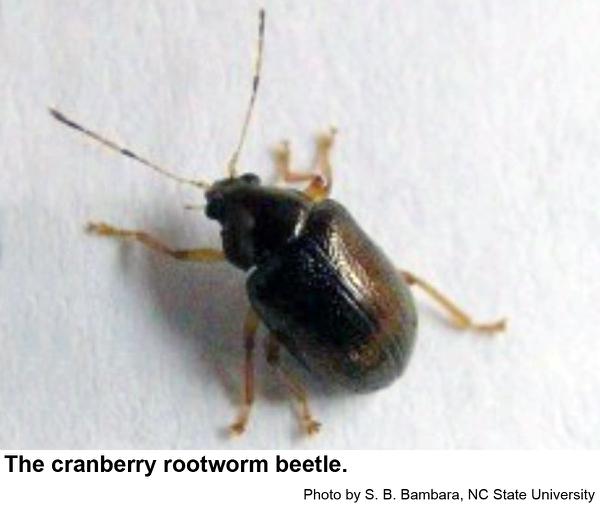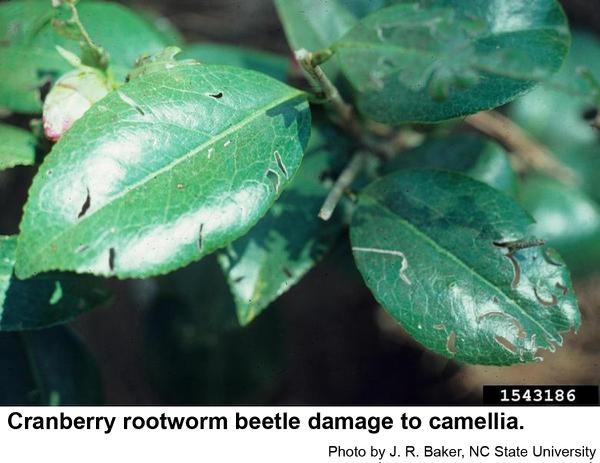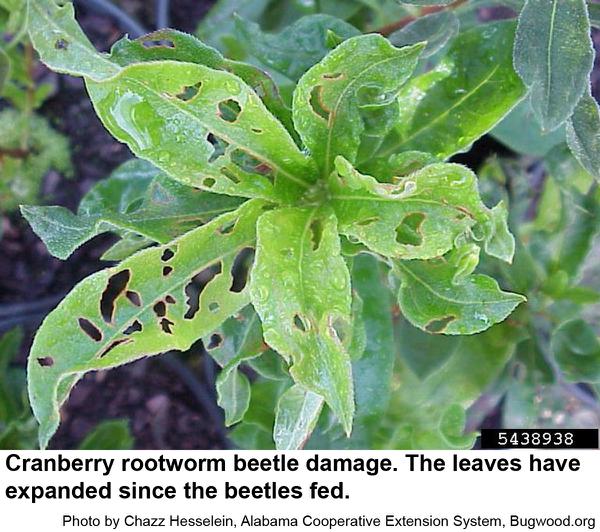Description and Biology
Cranberry rootworm beetles, Rhadopterus picipes, are small (about 1/5 inch long) and shiny brown. The immature stages, cranberry rootworms, are small, yellowish-white, slightly curved grubs with light brown heads and short legs. These rootworms overwinter in the soil. They pupate in April and May, and the new adults emerge in early June and are active until the end of July. After feeding for about 2 weeks, the beetles mate and females move under leaf litter to lay eggs. The adults are interesting in that they feed at night mostly on the new growth of various shrubs in the landscape. They chew characteristic narrow, straight or crescent-shaped holes. Females lay up to 150 eggs in clusters of 12 to 102 under leaf litter on the soil surface in July. After hatching 9 to 11 days later, the tiny young grubs dig down and start feeding on roots. Feeding lasts until October at which time the grubs are about 5/16 inch long. We have one generation per year in North Carolina.
Host Plants
Cranberry rootworm beetles feed on the new growth of camellia, photinia, rhododendron, and other shrubs and trees in the landscape as well as the foliage and fruit of cranberries. Magnolia, hollies, oaks, rose, silver maple, sycamore, sumac, sassafras, and Virginia creeper are also fed upon. The small rootworms feed on the bark of roots of blueberry, cranberry and probably other plants as well. The grubs are rarely reported in North Carolina.
Residential Recommendations
Sevin or another insecticide labeled for residential landscape use should give more than adequate control of cranberry rootworm beetles. Most big box stores and garden centers carry a number of pesticides from which to choose. Only the new growth needs to be treated. Fortunately, insect populations vary in abundance from year to year and in place to place so that most years it may not be necessary to treat for cranberry rootworms at all. Oliver and Chapin (1980) found that removing leaf litter reduced feeding by cranberry rootworm beetles perhaps because there was less suitable refuge for the beetles during the day.
References
- Arthropod Pests of Rhododendron. Bambara, S. 2010. Entomology Insect Notes, NC State Extension Publications.
- Chapter 9. Magnolia - Magnolia spp. Knox, G. W. et al. 2012. IPM for Select Deciduous Trees in Southeastern US Nursery Production.
- Field Evaluation of Azalea Species and Cultivars for Resistance to Azalea Lace Bug and Cranberry Rootworm. Robacker, C. D. and S.K. Braman. 1997. HortScience 32 (3): 482.
- Root-feeding Insects. Anonymous. No Date. Philip E. Marucci Center for Blueberry & Cranberry Research and Extension, New Jersey Agricultural Experiment Station, Rutgers University.
- The Cranberry Rootworm: Adult Seasonal History, and Factors Affecting Its Status as a Pest of Woody Ornamentals in Louisiana. Oliver, A. D. and J. B. Chapin. 1980. Journal of Economic Entomology, Volume 73 (1): 96–100.
- The Cranberry Rootworm. Scammell, H. B. 1915. Bureau of Entomology, USDA Bull. 263. 8 pp.
- Extension Plant Pathology Publications and Factsheets
- Horticultural Science Publications
- North Carolina Agricultural Chemicals Manual
For assistance with a specific problem, contact your local N.C. Cooperative Extension Center.
This Factsheet has not been peer reviewed.
Publication date: Jan. 20, 2018
Reviewed/Revised: Nov. 2, 2022
Recommendations for the use of agricultural chemicals are included in this publication as a convenience to the reader. The use of brand names and any mention or listing of commercial products or services in this publication does not imply endorsement by NC State University or N.C. A&T State University nor discrimination against similar products or services not mentioned. Individuals who use agricultural chemicals are responsible for ensuring that the intended use complies with current regulations and conforms to the product label. Be sure to obtain current information about usage regulations and examine a current product label before applying any chemical. For assistance, contact your local N.C. Cooperative Extension county center.
N.C. Cooperative Extension prohibits discrimination and harassment regardless of age, color, disability, family and marital status, gender identity, national origin, political beliefs, race, religion, sex (including pregnancy), sexual orientation and veteran status.



